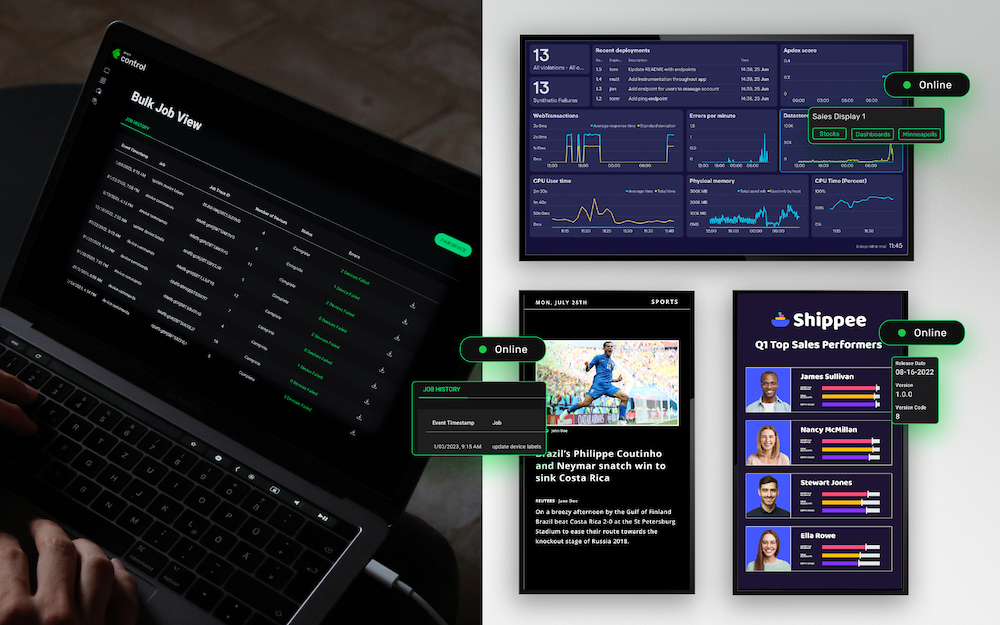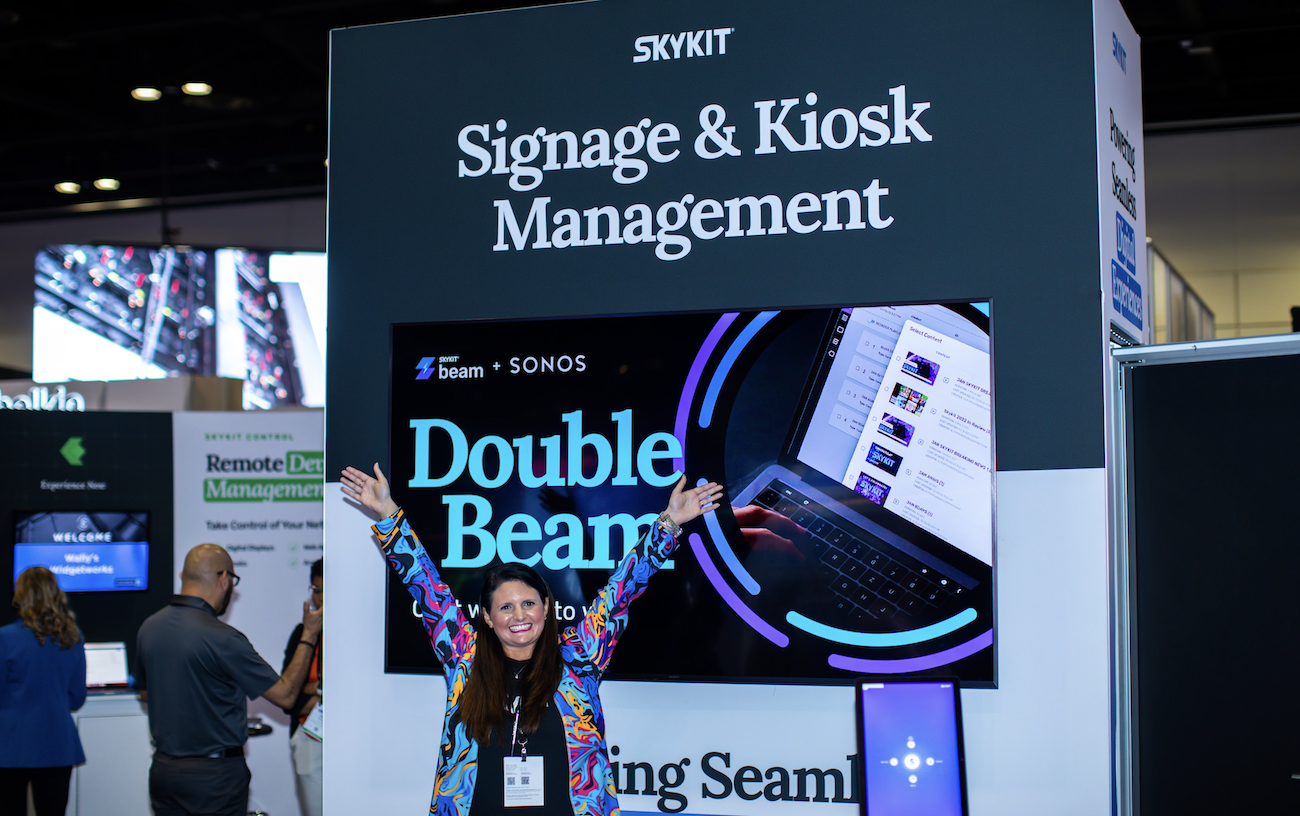Digital signage doesn’t become such a thing until it’s graced with good digital signage content. Until then, it’s merely hardware; typically an LCD or LED commercial grade screen connected to a media player.
Create Amazing Digital Signage Content That Works
Once the hardware is set up and a good cloud-based software solution is chosen for the media player, the next step is to create content that fits your purpose. Digital signage, after all, is used to generate interest and help make noise about your business. Powerful, purposeful content can get you there.
The questions that are left then are:
- What kind of content works for my digital signage marketing plan?
- Do I need video? Or images?
- Can I use both video and images, maybe with a live social media feed on the side?
The questions don’t end there:
- Should the video loop?
- How long should it loop?
- Does my audience want the campaign to be interactive?
- Would they prefer virtual?
With so many questions, it can be difficult to nail down the right answer.
Every scenario is different. From creating brand awareness to marketing a new product, retailers and businesses launch their strategies with three primary questions in mind:
- What do I want to achieve?
- Why do I want to achieve it?
- What are the results I want to see?
To help you determine what kind of content you need for your digital signage marketing plan, let’s take a look at a few different ways to create amazing content that works, based on best practices and already successful digital campaigns.
Let’s dig a bit deeper…
1) Design Best Practices
Here are some design and layout tips to consider before your team starts to create any content. Content should be clear and legible from at least 6 feet away.
These tips for digital signage content are recommended by HB Communications in collaboration with Brown University:
- Use Contrasting Fonts — When using video or images, an important rule of thumb is to always use fonts that are legible and are a color that contrast the background of the image. For example, if the font you use is light (white or beige), the background color on your screen should be dark (dark gray or black).
- 3 x 5 Rule — Less is more. Don’t overuse text to relay your message. Keep the font large, especially for headlines. When using text or bullet points, use three lines of text with five words, or five lines of text with three words.
- Text and Color — Don’t use more than one kind of font in your message. Try to avoid italicized words when possible, too. Use no more than two different colored fonts. Too many colors are unappealing to the eye.
- Simplicity — Keep the message simple. If there are too many elements crammed into one space, information can get lost. Emojis mixed with images mixed with too much text is also unappealing to the eye.
- Images — Avoid using images as a background over text, as the message can get lost easily. Stay with a solid background color and use the images to drive home points or highlight promotions and products, instead.
- Layout — Always make sure there is a buffer, or frame of clean space, around the edge of the screen. If your text is too close to the edge, the impact of your message is lost.
- Resolution — Displays for digital signage are almost always a 16:9 aspect ratio. This translates to an image resolution of 1920×1080. If the displays are oriented in ‘portrait’ mode, it is exactly the opposite.
Once in a while, the traditional non-wide-screen aspect ratio of 4:3, or 800×600 pixels, is still used.
Based on what it is you are trying to achieve, content creators need to determine how they will deliver their message. Sometimes video is used to attract the attention of the consumer.
Other times images are used.
In some cases, virtual reality is the medium.
2) Design Mediums
Based on what it is you are trying to achieve, content creators need to determine how they will deliver their message. Sometimes video is used to attract the attention of the consumer.
Other times images are used.
In some cases, virtual reality is the medium.
Here are the 5 kinds of mediums used most often in digital signage marketing:
Video
Video is king in content marketing. Because of the amount of information offered via social media and the Internet, the average attention span of you and me is eight to nine seconds. Knowing this, marketers are using video more and more to capture their audience. Take Coca-Cola’s “What’s In a Name” campaign, for example. Launched in Times Square in 2015 to reach a wider demographic, the soft drink giant was able to capture the attention of thousands in a matter of seconds. Not only did they remind the world of their powerful brand, but they got the world engaged, by incorporating social media, too. But, we’ll get to that in a moment.
Image and Text
Image and text are the most basic approach to digital signage content design, but that doesn’t mean it’s the most elementary as far as effectiveness. We see this a lot in the healthcare and educational space. In doctor office waiting rooms, some digital signs combine healthcare with education by offering tips to overcome the flu or other illnesses. Coupled with a voiceover, these bits of information are often looped to be played again after 20 or 30 minutes, depending on waiting room turnover.
Social Media Feed
Back to social media. (Because really, where would we be without it?) Businesses and corporations understand that creating a platform with which to engage consumers is a remarkable way to spread brand awareness across a series of social channels. The Royal Caribbean Cruise Line utilized this concept with Twitter’s live streaming video app, Periscope. In their November 2015 ‘Come Seek Live’ brand campaign, the cruise line busted out a digital marketing strategy that encouraged travelers to share some of their adventures on Periscope. The cruise line then sent edited versions of the live broadcasts to digital billboards in New York City. Those videos were shared all over the world and on various platforms. So if you’re wondering if incorporating a live social media feed would benefit your brand, look to Coca-Cola and Royal Caribbean. They don’t wonder, they know.
Virtual
Virtual reality is fun. It allows us to visit places we’ve not yet been and to experience things we may never get the opportunity to experience. In 2014, the Washington Redskins opened up to the public a Social Media Lounge at FedEx that featured an interactive gaming wall. On the wall, fans could put themselves in the game by attempt a virtual field goal. Meanwhile, on the other side of the world in Australia, an interactive sign that acted as a digital coloring book stopped residents in their tracks. The campaign was created to promote the relaunch of Deep Spring’s organic and sparkling mineral waters. Passer-bys could take a break in the middle of the day and color. I mean, how fun and virtually interactive is that.
Speaking of interactive…
Interactive
One of my favorite breakthrough digital innovations in digital signage is the interactive piece. In a recent blog post, we shared the case study of Beneful dog food. Beneful used a 64-foot interactive digital wall in a New York City subway to bring forth potential buyers. At the Columbus Circle subway station, the colorful wall boasted a commercial for dog food and snacks from the dog’s point of view. To get people to interact, the campaign used 3D cameras and gesture recognition technology. Those waiting for the subway could throw a ball virtually or pet a dog virtually. Interactive digital signage can create experiences that aren’t soon forgotten. If you saw and interacted with this giant digital wall, what kind of dog food would you think of the next time you went grocery shopping?
Conclusion
When faced with the question of how you should approach digital signage content creation for your own digital signage campaign, looking at successful case studies like the ones above is important. Some doctor offices are geared toward an older generation. Creating digital signage content with flashy video and encouraging social media interaction may not go over too well. Consider who your audience is while, again, taking in these three questions:
- What do I want to achieve?
- Why do I want to achieve it?
- What are the results I want to see?
From there, incorporate best design practices, bearing in mind our short attention spans today:
- Don’t use too many colored fonts.
- Avoid using splashy images as a background.
- Keep your message short and simple.
- Loop video based on estimated wait times.
- If it’s overwhelming for you to look at, it’s overwhelming for your audience.
Using a cloud-based software that offers easy-to-use templates and good customer service is a great beginning when it comes to digital signage content. Don’t settle for the basics. Go after what’s working with competitors. And finally, create something that is unforgettable. Think outside of the box when putting together content. We all want to keep up with the Joneses, but wouldn’t it be great to move beyond them?
Where are you stumped with your own digital signage content? Is your campaign not working? Why do you think it isn’t as effective as it could be?



